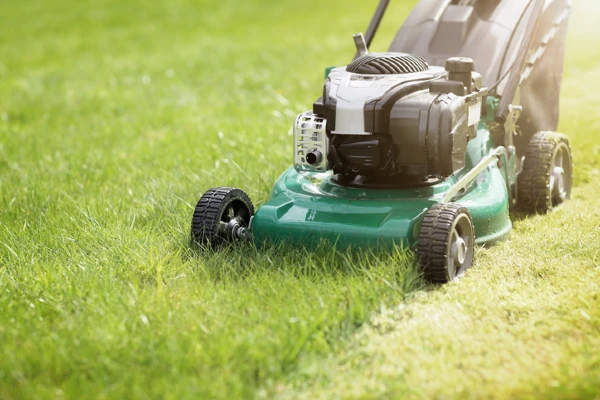What Seasons Are Best to Start and Stop Mowing?

Mowing your grass is an essential part of lawn maintenance. And, let’s be honest, mowing keeps your landscape looking pristine and magazine worthy. Maintaining a well-manicured lawn can also help deter pesky insects, promote photosynthesis, improve weed control, and aid in nutrient absorption in the soil.
Still, the question remains, “when should I start and stop mowing my lawn?”
We’re so glad you asked! Believe it or not, even when warm weather rolls in, that doesn’t mean every other week is the best time to mow the lawn. Certain factors could make mowing the lawn detrimental to healthy soil, root systems, and grass. Let’s talk more in-depth.
Springtime Mowing
In our 6b hardiness zone, cold-season grasses such as ryegrass and bluegrass are accustomed to occasional freezes and very hot summers, so they tend to bounce back after dormancy much sooner. Between March and April, dormant grass begins to grow again, setting off a chain reaction that indicates it’s the official start of the mowing season. However, before you pull out that push or ride-on mower, it’s important to know what time of day is best to mow in spring and learn a few mowing pro tips to keep with you.
Pro Tip #1: Don’t Mow in the Early Morning
Dew is synonymous with early spring mornings. And while this seasonal staple keeps your lawn moist, it’s not ideal when mowing. In fact, wet grass can clog your mower, cause operational issues, and leave unsightly tire marks on your lawn. Also, mowing when the wet grass helps spread fungal spores that infiltrate your soil and could damage your entire lawn.
Pro Tip #2: Keep Blades a Specific Length
Mowing, like cutting hair, involves knowing how much to remove to keep everything growing sufficiently and healthy. Germination is in full swing in spring, and the grass is coming out of dormancy. Mowing height should be around 2.5 inches warming the soil and eliminating the lingering frost.
Summer Mowing
With hotter temperatures in Gettysburg, your grass will continue to grow rapidly, but dryer conditions between May and September could cause soil drought. During peak temperatures, water will evaporate, making the soil and grass brittle. For this reason, ensure you’re waiting to mow until the evening when it’s cooler. You’ll also want to mow at the height of 3-3.5 inches to provide much-needed shade and insulation.
Pro Tip #3: Water Infrequently but Deeply
A common misconception about summer and lawn care is that you must amp up watering, or your plants and lawn will suffer. On the contrary, overwatering your lawn can be just as detrimental as anything else. As we mentioned above, mowing exposes soil to harsh conditions, requiring consistent nutrients to thrive through heat and potential drought. It’s important to maintain moisture retention and verify water reaches the soil and root system instead of sitting on grass blades, causing mold and disease.
Pro Tip #4: Change the Direction of Mowing
Have you seen those lawns that look impossibly well-maintained, mowed at a perfect 45-degree angle? Angled mowing isn’t just for aesthetics (although it is easy on the eyes); it also promotes upright shoot growth. We recommend changing the angle and direction of every other mow for the manicured look and soil compaction prevention.
We use lawn stripers on our equipment to give you the proportioned angled lines you see on other lawns. While you can purchase these nifty devices almost anywhere, we suggest leaving the striping to lawn care professionals. Store-bought products are rarely as effective as our industrial-grade equipment. The last thing we want is for your lawn to be damaged because of poorly manufactured landscaping tools.
Fall Mowing
Typically, mowing stops in the fall because grass becomes dormant and doesn’t grow nearly as fast as in spring and summer. Certain turfgrass, such as Kentucky bluegrass, stops growing when the temperature stays below 50 degrees consistently. This is when you need to adjust your mowing schedule and cut back on frequent mowing.
Our lawn care professionals recommend you adjust your scheduled mowing to once every 2.5 to 3 weeks in the fall. You’ll want to completely stop mowing your Gettysburg lawn between October and November.
Pro Tip #5: Aeration After Fall Mowing is Key
Compacted soil is more common for commercial lawns and grass with excessive foot traffic. Mowing, regardless of how frequently (or infrequently) it’s completed, can play a role in soil compaction. Aerating should be done in September after mowing to loosen the topsoil and allow for nutrients to easily reach root systems.
Pro Tip #6: Keep the Rake Nearby
Fall leaves are a mesmerizing sight to behold. However, if you’re not careful, the colorful foliage could create serious issues for your recently mowed lawn. While grass clippings are good for your turf, allowing wet debris to build up isn’t beneficial. After mowing, you should rake soggy leaves and other debris to avoid fungi growth. Raking also helps prevent thatch (a combination of living and dead plants that sit at the base of grass), which can suffocate your lawn and inhibit vital nutrients from reaching root systems.
For More Pro Tips & Pro Results, Hire The Grounds Guys of Gettysburg!
The question should no longer be, “when should I start and stop mowing my lawn?” Instead, you should be asking, “when can I get a professional to help with mowing?” The answer is: anytime! The Grounds Guys of Gettysburg is ready to take the task of mowing off your hands. We’ll work with you to plan an appropriate mowing schedule and incorporate other lawn maintenance duties as needed.
To get started, call or request a free estimate today!


